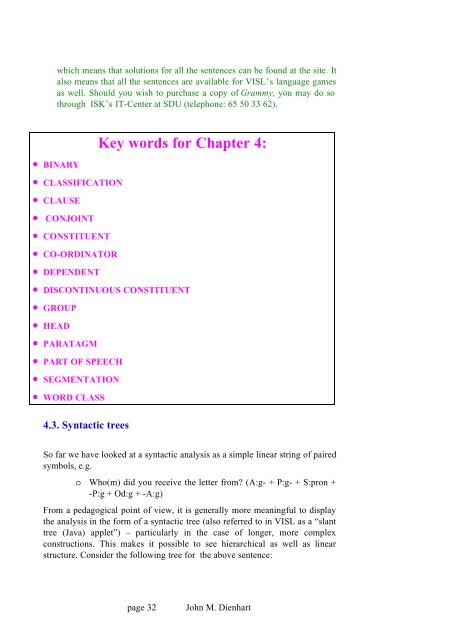Download - VISL
Download - VISL
Download - VISL
You also want an ePaper? Increase the reach of your titles
YUMPU automatically turns print PDFs into web optimized ePapers that Google loves.
which means that solutions for all the sentences can be found at the site. It<br />
also means that all the sentences are available for <strong>VISL</strong>’s language games<br />
as well. Should you wish to purchase a copy of Grammy, you may do so<br />
through ISK’s IT-Center at SDU (telephone: 65 50 33 62).<br />
Key words for Chapter 4:<br />
• BINARY<br />
• CLASSIFICATION<br />
• CLAUSE<br />
• CONJOINT<br />
• CONSTITUENT<br />
• CO-ORDINATOR<br />
• DEPENDENT<br />
• DISCONTINUOUS CONSTITUENT<br />
• GROUP<br />
• HEAD<br />
• PARATAGM<br />
• PART OF SPEECH<br />
• SEGMENTATION<br />
• WORD CLASS<br />
4.3. Syntactic trees<br />
So far we have looked at a syntactic analysis as a simple linear string of paired<br />
symbols, e.g.<br />
o Who(m) did you receive the letter from? (A:g- + P:g- + S:pron +<br />
-P:g + Od:g + -A:g)<br />
From a pedagogical point of view, it is generally more meaningful to display<br />
the analysis in the form of a syntactic tree (also referred to in <strong>VISL</strong> as a “slant<br />
tree (Java) applet”) – particularly in the case of longer, more complex<br />
constructions. This makes it possible to see hierarchical as well as linear<br />
structure. Consider the following tree for the above sentence:<br />
page 32<br />
John M. Dienhart
















